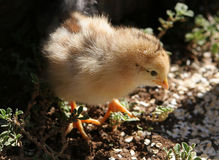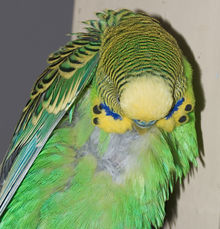The down of birds is a layer of fine feathers found under the tougher exterior feathers. Very young birds are clad only in down. Powder down is a specialized type of down found only in a few groups of birds. Down is a fine thermal insulator and padding, used in goods such as jackets, bedding, pillows and sleeping bags. The discovery of feathers trapped in ancient amber suggests that some species of dinosaur may have possessed down-like feathers.
Description and etymology


The word down comes from the Old Norse word dūnn, which had the same meaning as its modern equivalent.[1] The down feather is considered to be the "simplest" of all feather types.[2] It has a short or vestigial rachis (shaft), few barbs, and barbules which lack hooks.[3] There are three types of down: natal down, body down and powder down. Natal down is the layer of down feathers which cover most birds at some point in their early development. Precocial nestlings have such a down layer when they hatch, while altricial nestlings develop their down layer within days or weeks of hatching. Megapode hatchlings are the sole exception; they are already covered with contour feathers when they hatch.[4] Body down is a layer of small, fluffy feathers that lie underneath the outer contour feathers on a bird's body.[5]
Powder down is a special type of down which occurs in a few groups of apparently unrelated birds. In some species, the tips of the barbules on powder down feathers disintegrate, forming fine particles of keratin, which appear as a powder, or "feather dust" among the feathers. These feathers grow continuously and are not molted.[6] In other species, powder grains come from cells that surround the barbules of growing feathers.[7] These specialized feathers are typically scattered among ordinary down feathers, though in some species, they occur in clusters.[3] All parrots have powder down, with some species (including the Mealy Parrot) producing copious amounts.[8] It is also found in tinamous and herons.[3] The dust produced from powder down feathers is a known allergen in humans.[9] Birds with powder down usually have a reduced uropygial gland, but not all birds with vestigial or missing uropygial glands possess powder down.
Function
The loose structure of down feathers traps air which helps to insulate the bird against heat loss,[5] and contributes to the buoyancy of waterbirds.[10] There is some evidence that down feathers may also help to decrease the incidence of nestling cannibalism among some colonially nesting species, as the stiffness of the feathers make the young more difficult to swallow.[10]
Mutation
Mutations in the genes that control the formation of down feathers have been recorded in a German White Leghorn flock. Although the elements of a normal down feather are present, a hyperkeratosis of the feather's horny sheath after 16–17 days of incubation results in the sheath not splitting as it should during the final stages of the feather's growth. Because of that abnormal splitting, the bird's down appears to be matted; chicks with this condition look bristly and singed, and tend to be lighter in body weight than normal chicks are.[11]
Human use
Down feathers were used by indigenous North Americans for religious ceremonies and as powerful symbols. In the stories of some cultures, the down feathers of an eagle were important gifts given by the bird to the story's hero.[12] In the Ghost Dance, a religious movement that became particularly widespread among the Plains Indians, each dancer held a painted feather which was tipped with a down feather painted with another color; the feathers were generally those of a crow, which was sacred to the Ghost Dance, or of an eagle, which was sacred to all tribes.[13] Zuni prayer sticks were also made using eagle down. While eagle feathers belonged to the Sun Priest, who planted them to the sun, other priests could use them if rain were needed, as the down is said to suggest "fleecy clouds that gather on the horizon before rain". The Hopi rubbed eagle down feathers over rattlesnakes being collected for their Snake Dances, in an effort to soothe and calm the reptiles.[14]
Nowadays, down is used primarily for its excellent insulating properties. It offers excellent thermal properties, and has good lofting characteristics. This means that the down traps small pockets of air efficiently. The small pockets of air provide the thermal barrier. Down has the added property that it can be packed into a very small space.
For outdoor equipment, down is considered to be the single best insulating material available due to its light weight, compressibility, and heat retention. Down insulation can be quite expensive, so alternatives, known as synthetic insulation, are available. Synthetic insulation types generally cost less and are usually not as lightweight or as compressible as down. However, synthetic insulations work better than down when wet and are easier to dry, whereas down insulation does not work at all when wet and takes a very long time to dry out. Thus people who expect a significant amount of rain when camping will either bring a down sleeping bag with a water-resistant shell, or a bag with synthetic fill.
Down insulation is rated by fill power, measured as the number of cubic inches displaced by a given ounce of down (in3/oz). Higher fill-power downs will thus insulate better than lower fill-power downs of the same weight. Insulation in most outdoor equipment ranges from about 400 to 900 in3/oz (230–520 cm3/g). Down rated 500-600 in3/oz (290–360 cm3/g) is warm enough and light enough for most conditions, and 800-900 in3/oz (460–520 cm3/g) fill is used for very lightweight and/or very cold-weather gear.
When wet the thermal properties of the down are virtually eliminated, making it a worse insulator than most equally wet synthetic fills. Compressed down is also a very poor insulator, and thus sleeping bags insulated with down require the use of a sleeping pad to provide insulation from warmth that would otherwise be conducted into the ground.
Methods of harvesting
Down can be collected in a variety of ways. Birds which provide the feathers may be used for other purposes, for example to provide meat. Some birds are killed solely for their down, while some birds (particularly some geese) are periodically live-plucked of their breast feathers. Some birds, such as the eider duck, line their nests with down, and such down is harvested safely after the young leave the nest.
Animal welfare groups consider the live-plucking of down to be a cruel, painful procedure, particularly since birds undergo down collection repeatedly.
This article is copied from an article on Wikipedia® - the free encyclopedia created and edited by online user community. The text was not checked or edited by anyone on our staff. Although the vast majority of the Wikipedia® encyclopedia articles provide accurate and timely information please do not assume the accuracy of any particular article. This article is distributed under the terms of GNU Free Documentation License.

No comments:
Post a Comment